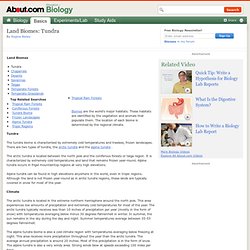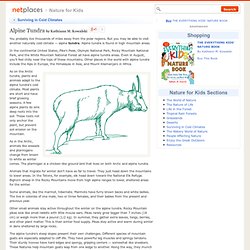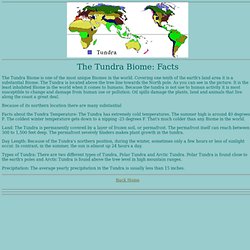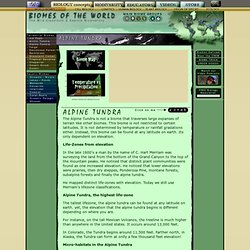

Arctic Tundra Biome. History of a name: The word tundra is believed to come from the Finnish word "tunturia" which refers to a treeless plain.

This feature helps define the tundra. In transition zones from other biomes, such as the taiga or coniferous forests, stunted trees and shrubs are all that grows. Another factor that helps define the vegetation in the tundra, and thus the tundra itself is the presence of permafrost, a layer of permanently frozen ground just below the surface. Where is it found? Arctic tundra is found almost entirely in the Northern Hemisphere. Climate In the arctic tundra there are two seasons: winter and summer. Precipitation levels in the tundra are from 6 to 10 inches a year. Flora and Fauna On a relative scale, the arctic tundra biome has a relatively low biodiversity. Many animals migrate to the tundra in the summer months to take advantage of the lack of predators, abundant plants, insects, and fish. Text by Rob Nelson April 2007. Land Biomes: Tundra. Land Biomes Biomes are the world's major habitats.

These habitats are identified by the vegetation and animals that populate them. The location of each biome is determined by the regional climate. Tundra The tundra biome is characterized by extremely cold temperatures and treeless, frozen landscapes. The arctic tundra is located between the north pole and the coniferous forests or taiga region. Marmots. Alpine Tundra - Nature for Kids. You probably live thousands of miles away from the polar regions.

But you may be able to visit another naturally cold climate — alpine tundra. Alpine tundra is found in high mountain areas. In the continental United States, Pike's Peak, Olympic National Park, Rocky Mountain National Park, and the White Mountain National Forest all have alpine tundra areas. Even in August, you'll feel chilly near the tops of these mountains.
Other places in the world with alpine tundra include the Alps in Europe, the Himalayas in Asia, and Mount Kilamanjaro in Africa. As on the Arctic tundra, plants and animals adapt to the alpine tundra's cold climate. As in the Arctic, animals like weasels and ptarmigans change from brown to white as winter comes. Animals that migrate for winter don't have as far to travel. Tundra Facts. Undefined The Tundra Biome: Facts The Tundra Biome is one of the most unique Biomes in the world.

Covering one tenth of the earth's land area it is a substantial Biome. Fast Facts on Biomes in the Tundra. Northern Lights Explained - Aurora Borealis. Tundra Plants. Alpine Tundra Biome. The Alpine Tundra is not a biome that traverses large expanses of terrain like other biomes.

This biome is not restricted to certain latitudes. It is not determined by temperature or rainfall gradations either. Instead, this biome can be found at any latitude on earth. Its only dependent on elevation. Life-Zones from elevation In the late 1800's a man by the name of C. He mapped distinct life-zones with elevation. Alpine Tundra, the highest life-zone The tallest lifezone, the alpine tundra can be found at any latitude on earth. yet, the elevation that the alpine tundra begins is different depending on where you are. Student assignment. (requirement for course by Peter Kabai) Wildlife Ecology 2004 Marit Brekk, veterinary student, English program, 1st year.

The wolverine, Gulo gulo, is a medium-sized carnivore and the largest terrestrial member of the weasel family Mustelidae. They occupy vast areas of the tundra and boreal forest in North-America, Scandinavia and Asia at very low densities. Their appearance is somewhat bear-like, although movement and associated behaviour are distinctly characteristic of the weasels. Wolverines are powerfully built, with structural morphology apparently adapted for cold, harsh conditions.
Males (12-18 kg) are typically 30-40% larger than females (8-13kg). After reading the Action plan for the Conservation of Wolverines in Europe ( worked out and written by Norwegian, Swedish and Finnish ecologists and nature researchers, I decided to use this report as a source to find out about the situation of the wolverine population in Scandinavia, with the mainlook on . Distribution (Enkarta encyclopedia, Mikrosoft ( Wolverines and humans.